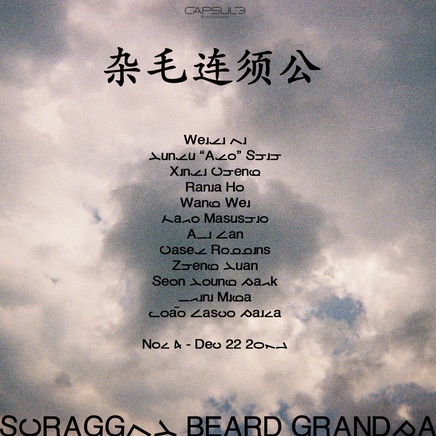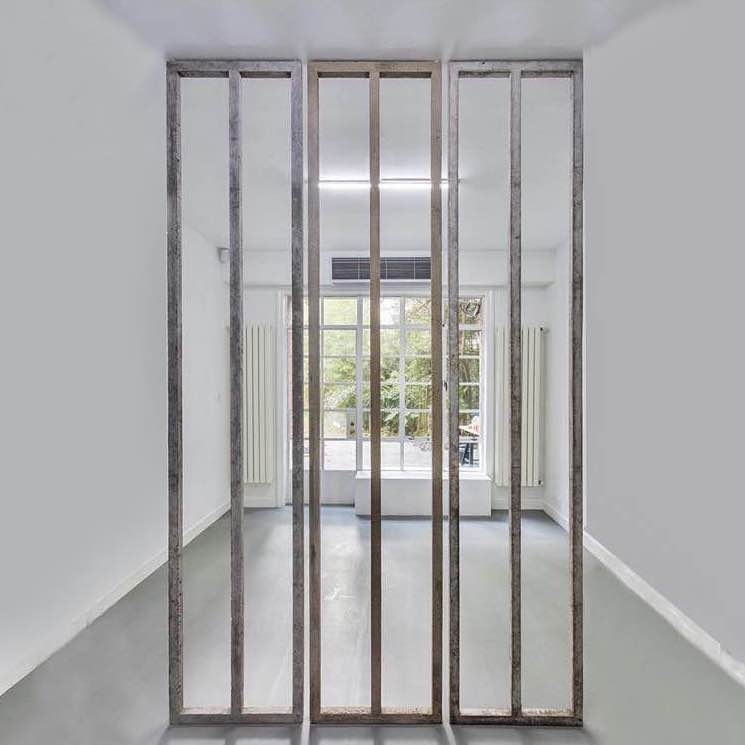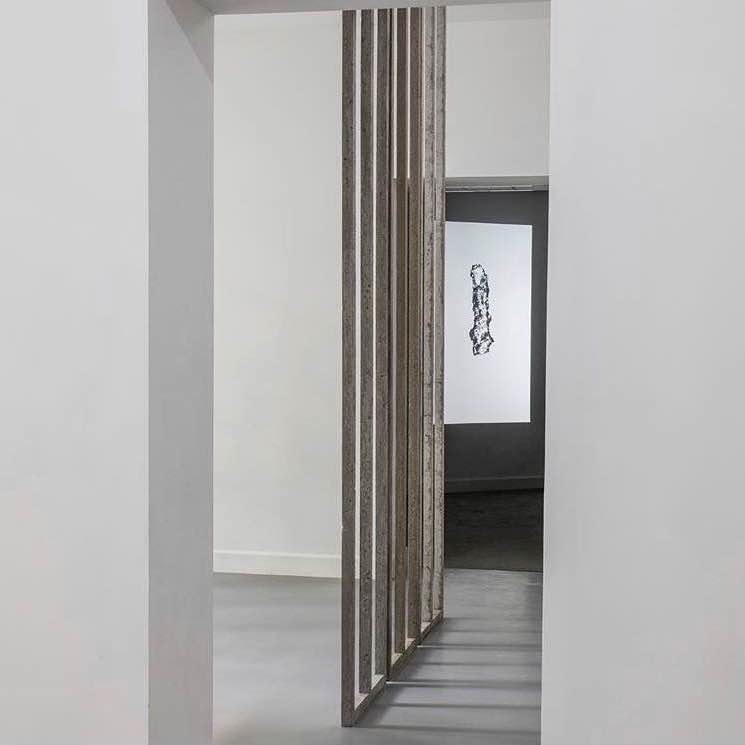杂毛连须公
SCRAGGLY BEARD GRANDPA
2017.11.4-2017.12.22
《雜毛連須公》在膠囊上海展出。參展的十二位藝術家曾經於2015-2016年駐留過PRACTICE紐約,包括李維伊、施昀佑、程心怡、何穎宜、王衛、增鹽太郎、萬振宇、Casey Robbins、鄭源、樸宣映、Irini Miga和João Vasco Paiva。展覽由兩位 PRACTICE 創始人 Cici Wu 和王旭策劃,
A group show of Weiyi Li, Yunyu “Ayo” Shih, Xinyi Cheng, Rania Ho, Wang Wei, Taro Masushio, Ali Van, Casey Robbins, Zheng Yuan, Seon Young Park, Irini Miga, and João Vasco Paiva who stayed at PRACTICE (New York) from 2015-2016. This show is curated by Cici Wu and assembled by Wang Xu, both co-founders of PRACTICE.

無須費皮[1],
開始這封信的時候是在 PRACTICE 成立了兩年之後,在這之間我們與很多不同身份背景的藝術家共同經歷了十五個項目與展覽。PRACTICE 由三個出生於中國的藝術家在紐約創辦,作為我們的工作室(又是一個免費的,給除了創始人以外的藝術家創作、住宿的地方),也是一個展覽空間、火鍋店、麻將館。和我們合作的藝術家裏分別有出生於韓國、日本、希臘、美國、克羅地亞、葡萄牙,也有一些是出生在一個地方然後在大西洋的另一邊長大的。但是這種現象在紐約並不算什麽,是一件正常的事情。今天寫這封信主要是想更新一些想法,不過未必是從一個宏觀的角度入手(有時候我們總是在統一很多細微的事物),我想從一個比較近又真實的地方開始——語言(障礙)與友情(同齡藝術家之間)的變化。
1998年張洹到達紐約之後,誰是他最好的朋友?蔡國強曾經在紐約最好的非中國的好朋友又是誰?他們之間的在和Irini Miga, 增鹽太郎(Taro Masushio), 樸宣映(Seon Young Park), 萬振宇(Ali Van), João Vasco Paiva, Casey Robbins, 施昀佑(Yunyu “Ayo” Shih), 王衛(Wang Wei), 何穎宜(Rania Ho)聊天的時候,PRACTICE 總是會不斷得到新的啟發,他們像是一面面鏡子,讓我們看到原來自己可以擁有多過一雙眼睛(想象有很多天眼在你的身體上打開的時候)。英語的確不是我們的母語。我們都是從模仿開始。我們甚至不知道這是否是必要的(來不及給出判斷),但是我們都自然地變成了雙語、三語(在朝鮮日治時期的時候難民們被迫逃亡到偽滿洲開始學習中文——唯一的交流語言,他們的母語變成耳語,只能在夜晚,以最輕地音量被吞吐出來,為了不要忘記)[2]
我們從來都沒有機會去考慮或者決定是否需要這些語言,但是在來不及應對的情況下已經學會了。好在遇到了來自於不同國家背景的朋友們,雙語和三語(計算機語言)變成了溝通的基礎,開啟了不同的思維(邏輯)模式,讓語言從工具變成習慣再變成遊戲。
在 PRACTICE 有許多夜晚都是在不斷的講話,也不全都是深入的討論,有的時候我們也會吵架。情緒化這個詞很適合 PRACTICE,也許是因為三個創始人都來自一個感情用事的地方。人和人總是有一層感情(面子、關系、義氣、家庭)為主導的薄膜。這也讓許多藝術家都見證了“中國式”—— 吵架,同時他們也體驗了“中國式”的另一面——分享(無私的幫助別人)、信任、質樸(對苦難承受的能力)還有一種與生具來的諒解。我總覺得這是PRACTICE作為一個在紐約藝術空間最特別的地方(除了它漫無目的的態度以外)。另一方面,像是程心怡(Xinyi Cheng), 李維伊(Weiyi Li), 鄭源(Zheng Yuan)是出生於中國,之後到美國讀書的藝術家,我們本就相遇在美國,對自己的身份和故鄉的文化產生許多疑問。我們會寄一些郵件,交流彼此的想法——在 PRACTICE 相聚之後,更多的是分離,能夠在一起的時間並不長。大家都有不同的使命,生活在不同的地方。但是曾經的聯結卻是深刻的,足夠影響一點彼此的創作與生命。
除了Warhol(1928-1987)與 Beuys(1921-1986) 之外,我們也應該記得Robert Filliou(1926-1987)。他創立了“和藹共和國”—— 一個超越了國家界限的理想社會,強調好奇心的獨立性,以及個人的重要性,每一個人都可以是自己的領土。
今天中午我和朋友打電話,“在你做作品的時候你會想些什麽?”我問道,他說:“我會想……這件作品是不是在給這個世界又多添一件垃圾。”(耳邊響起了另一個來自1991年的聲音,“你相信自己沖擊了西方藝術界嗎?”)[3]
文化是一種結果,人們生產與消費的結果,根據人的需要與信仰。而這些需要與信仰應該是可以被歷史的、科技的、地理的、經濟的因素所解釋通的。而故鄉的文化到底是什麽呢?無論是迫於無奈的出走,還是流連於過多選擇的困惑,當每一天結束的時候,我知道我身邊有一些小夥伴們。通過時間與空間,我們的友誼在逐漸改變我們的身份。[4]
[1] 無須費皮,費大為的筆名,用於 1991 年給栗憲庭的一封信中。Pseudonym of Fei Dawei, used in a letter to Li Xianting in 1991.
[2] 韓裔美籍藝術家車學敬(Theresa Hak Kyung Cha)借由書寫自己與國族的寓言小說《聽之認之》,1982 年。Excerpt from Dictee, an auto-ethnographic novel about the self and nation-states by Korean-American artist Theresa Hak Kyung Cha, 1982.
[3] 栗憲庭於 1991 年寫給費大為的信中提到的問題。A question that Li Xianting asked in his letter to Fei Dawei in 1991.
[4] Press release of Mathew Berliner Mauer, Amy Lien and Enzo Camacho, 2014.
No Beard Fei [1],
This letter is penned after PRACTICE was created two years ago, within which we have experienced fifteen projects and exhibitions with artists from vastly different backgrounds. PRACTICE was founded in New York by three artists born in China, and has served as our studio (plus a free space for artists to work and sleep), an exhibition space, hotpot restaurant, and mahjong house. The artists with whom we have collaborated were born in Korea, Japan, Greece, the United States of America, Croatia, Portugal, and Taiwan, with several artists born in one place but raised on the other side of the Pacific or Atlantic Ocean. But this phenomenon is nothing rare in a place like New York; in fact, it is quite common. I’m writing this letter today to update some thoughts, though not necessarily from a bird’s eye view (we often find ourselves trying to unify many minute and fine things). I would like to start from a very intimate and real place—changing language barriers and friendship between peer artists.
When Zhang Huan arrived in New York in 1998, who was his best friend? Who was Cai Guo-Qiang’s non-Chinese best friend in New York? What was the conversation between them about? Does the meaning of life reside in studying other cultures and reflecting on one’s own? Why do people care or not care about these issues? Here at PRACTICE we shared much happiness. It came partly from artists’ desires to create, partly from the necessity for and pleasure from communication. This kind of communication didn’t revolve around eating, drinking, or gossip, but rather questions generated out of states of urgency, regarding society, geography, economics, life, physics, and art. In the process of conversing with Irini Miga, Taro Masushio, Seon Young Park, Ali Van, João Vasco Paiva, Casey Robbins, Yunyu “Ayo” Shih, Wang Wei, and Rania Ho, PRACTICE continually found new inspirations. These artists are like mirrors, in the sense that they allow us to see with more than one pair of eyes. Imagine what it’s like when many pairs of eyes flutter open on the same body. It is true that English isn’t our mother tongue. We all started from mimicking. Without even knowing whether it was absolutely necessary (there wasn’t enough time to make a decision), we all naturally became bi-lingual, tri-lingual (during the period of Korea under Japanese rule, refugees escaped to Manchuria and studied Chinese, which was the only mandatory language used for communication. Their mother tongue was forbidden into whispers: only at night could they be enunciated as lightly as possible, for the sole purpose of not forgetting)[2].
We never had the opportunity to think over or decide whether we needed these languages, but before we could respond, we had already learned them. It’s luck that we have encountered friends from different countries and backgrounds, our bi-lingual or tri-lingual (computing language) tongues not only served as the basis for communication, but also opened up new modes of thinking (logic). Language, evolving from being a tool to a habit, became a game.
We spent many nights at PRACTICE just talking. These conversations were not always profound, and sometimes we even fought for trivial things. The word “emotional” is especially suited for PRACTICE, perhaps because the three founders came from a place that acts on emotional impulses. People are always held together by a thin membrane led by emotions (mianzi, guanxi, yiqi, family). As such, many artists witnessed the so-called “Chinese way” of fighting, but they also experienced the “Chinese way” of sharing (selflessly helping others), trust, modesty (the ability to withstand adversity), as well as a forgiveness that seemed to run in our blood. I always thought this was the most unique character that made PRACTICE stand out as an artists-run space in New York (that is, aside from its deliberate purposelessness). On another level, artists like Xinyi Cheng, Weiyi Li, and Zheng Yuan were all born in China and came to study in the US. We met in the US, and started to question our identity and the culture of our homeland. We all thought of emailing each other to keep in contact—we didn’t have long to stay together. Everyone lived in a different place—each had his or her own mission. But those momentary connections forged in the past were profound enough to slightly shape each other’s work and life.
Asides from Warhol (1928-1987) and Beuys (1921-1986), we should also remember Robert Filliou (1926-1987). He came up with the “Genial Republic”, which aimed to be an ideal society beyond national affiliation and underscored the independence of the inquisitive. Each person is their own territory.
I was on the phone with a friend at noon today. “What do you think of when you make work?”, I ask. He answered: “I would think…am I adding a new piece of garbage to this world?” (Another voice from 1991 starts ringing in my ear: “Do you believe that you have made an impact on the Western art world?”)[3]
Culture is a kind of fruit, the result of production and consumption, shaped according to people’s needs and beliefs. Yet these needs and beliefs should be explained by historical, technological, geographical, and economic determinants. What is the culture of our homeland? Whether we left because we have no choice, or we linger at the confusion of having too many choices, at the end of the day I know that I have some little friends by my side. Through time and space, our friendships gradually change our identity.[4]
Special thanks: Capsule Shanghai, Terence Chan, Guo Juan, Ho King Man, Banyi Huang, Carol Lu, Taro Masushio, Xiaofei Mo, Wang Xu, Cici Wu, all the artists.
[1] Pseudonym of Fei Dawei, used in a letter to Li Xianting in 1991.
[2] Excerpt from Dictee, an auto-ethnographic novel about the self and nation-states by Korean-American artist Theresa Hak Kyung Cha, 1982.
[3] A question that Li Xianting asked in his letter to Fei Dawei in 1991.
[4] Press release of Mathew Berliner Mauer, Amy Lien and Enzo Camacho, 2014.
Special thanks: Capsule Shanghai, Terence Chan, Guo Juan, Ho King Man, Banyi Huang, Carol Lu, Taro Masushio, Xiaofei Mo, Wang Xu, Cici Wu, all the artists.

BEFORE IT HAPPENS 在發生之前
(photo credit: Capsule Shanghai)

BEFORE IT HAPPENS 在發生之前
(photo credit: Capsule Shanghai)